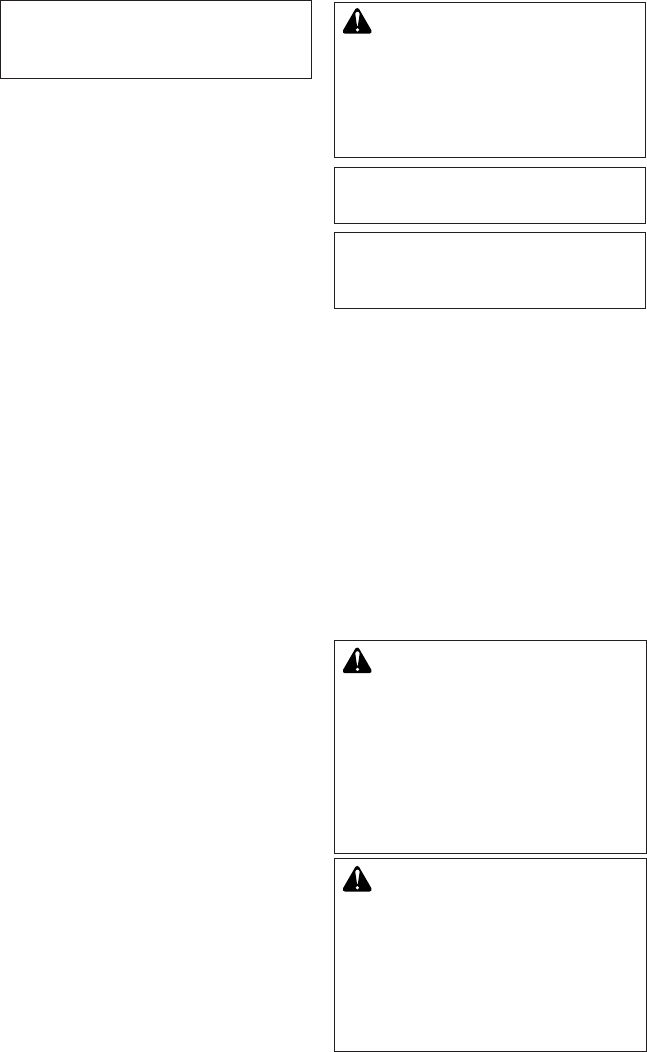
www.fmiproducts.com
116646-01J8
VENTING INSTALLATION
WARNING: Read all instruc-
tions completely and thoroughly
before attempting installation.
Failure to do so could result in
serious injury, property damage
or loss of life.
NOTICE: Failure to follow these in-
structions will void the warranty.
NOTICE: Do not seal vent cap
to pipe. Cap must be removable
for service.
INSTALLATION PRECAUTIONS
•
Wear gloves and safety glasses for protection
• Use extreme caution when using ladders
or when on roof tops
• Be aware of electrical wiring locations in
walls and ceilings
The following actions will void the warranty
on your venting system:
• Installation of any damaged venting com-
ponent
• Unauthorized modication of the venting sys-
tem (Do not cut or alter vent components)
• Installation of any component part not
manufactured or approved by FMI PROD-
UCTS, LLC
• Installation other than as instructed by
these instructions
WARNING: This gas replace
and vent assembly must be vented
directly to the outside. The venting
system must NEVER be attached
to a chimney serving a separate
solid fuel burning appliance. Each
direct-vent gas appliance must use
a separate vent system. Do not use
common vent systems.
WARNING: Vent pipe air space
clearances to combustibles are
1" on all sides except on the hori-
zontal sections, which require 2"
clearances from the top of the
pipe. Where the termination cap
penetrates a combustible wall, 1"
air space clearance is required.
NOTICE: Read these instruc-
tions completely before attempt-
ing installation.
These models are tested and approved for
use with FMI PRODUCTS, LLC (direct-vent)
pipe components and terminations.
The venting system must terminate on the
outside of the structure and can not be at-
tached to a chimney or ue system serving a
separate solid fuel or gas burning appliance.
A direct-vent appliance must have its own
venting system. DO NOT common vent this
appliance.
These models are approved to be vented
either horizontally through an outside wall or
vertically through a roof or chase enclosure
using the following guidelines:
• When venting system terminates horizon-
tally on an outside wall, you may install
a standoff if the termination cap is to be
installed directly on a combustible nish
such as vinyl, wood, stucco, etc.
• Never run the vent downward as this may
cause excessive temperatures which could
cause a re.
• Vent pipe air space clearances to com-
bustibles are 1" on all sides except on the
horizontal sections, which requires 2" clear-
ance from the top of the pipe. Where the
termination cap penetrates a combustible
wall, 1" air space clearance is required.
• Snorkel terminations are required when
minimum clearance to grade cannot be
met (see Figure 16 on page 12).
• Have replace and selected vent compo-
nents on hand to help determine the exact
measurements when elbowing or offsetting.
Always use wall restops when penetrating
walls and restops when penetrating ceil-
ings or attic spaces.
• If using a venting conguration of only
horizontal venting with no vertical run, a
1/4" rise for every 12" of run toward the
termination is required.
• For installation of replace at elevations of
4000 feet or greater, pay special attention
to venting requirement recommendations.


















